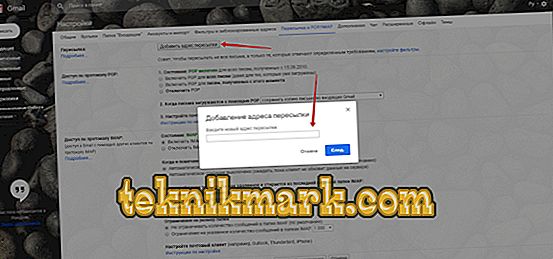E-mail is a modern, worthy alternative to the old letter exchange format, through post offices, with more extensive and operational capabilities. Each person using a computer device has a personal e-mail inbox, and some are not one, for example, for work information, personal data and other subjective purposes. Often, people who have several email domains in electronic format, there is a need to combine all incoming letters in a single place by redirecting correspondence to a specific address. Combining incoming correspondence significantly optimizes the user's work, due to the absence of the need to check each email box several times a day, which takes a lot of time. The implementation of this task is feasible in practice, however, the procedure differs slightly in the implementation process, depending on the type of Internet mail portal being operated. In this article we will explain how to set up mail forwarding, having considered the most popular options for electronic portals: mail, Gmail and Yandex.

Set up email forwarding.
Features of data redirection from mail.ru domain
The electronic portal for mail exchange mail.ru is the most popular among users, it has a large number of users due to ease of use, regular and reliable operation. The functionality of the portal allows the redirection of letters to another address, and authorizes the admissibility of both redirecting all mail and a separate category of notices that fit specific user-defined requirements. Initially, we will consider the regulations on how to redirect all mail to another e-mail box that is available in the user's operation:
- First you need to go to the "Settings" item in your email account, where to choose the category "Filtering Rules".

- In the window that opens, under the heading “My filtering rules”, click on the caption “Add transfer”.

- In the window that appears, fill in the line “Forward all emails to the address” by typing in it the actual email to which the user wishes to receive mail.

- The system will request a PIN from the specified domain, after the introduction of which a confirmation letter will be sent to it.
- To complete the process, the user must follow the link indicated in the letter.
In order for the redirection to be activated, you will need to once again go to the "Filtering Rules" and move the mark from the "Off" position to the "Enabled" state, located at the bottom of the screen, opposite the "Forward all emails to the address ..." sign.

If the transfer of absolutely all mail is not relevant, you can redirect part of the letters by specifying the filtering criteria by which the system will allocate notifications corresponding to the specified parameters. To set up the redirection of letters of specific content, you need to go to the "Filtering Rules" through the "Settings" where you select the "Add Filter" item, and fill in the filter field, specifying the required parameters in it. These can be either sender names or individual words that appear in the message, the amount of text or other characteristics necessary for the addressee. It remains only to specify the new email recipient and complete the procedure as described above.
The procedure for the forwarding of letters in Yandex
Resources "Yandex" also allow you to configure the forwarding of incoming correspondence to another mail. Configuring mail forwarding from Yandex.Mail on the execution process is similar to the procedure described above, however, it has some differences in terms of section names and technology for making changes. The e-mail "Yandex" is redirected to another mailbox according to the following instructions:
- First you need to log in to “Yandex” with your username and password.
- Next, through the "All Settings" section, go to the "Rules for processing letters", where you can set up forwarding.

- Forwarding from “Yandex” mail to another email box can be performed for all letters, as well as for partial correspondence, in one window.
- In the window that opens, you need to fill in the standard template, where filters are marked, if the addressee wishes that the redirection does not apply to all letters, or close the filter with a “red cross”, when the transfer will concern all correspondence without exception.
- In the line "Forward to the address" it is necessary to prescribe the address where the redirection should be carried out.
- Confirmation of the changes made in Yandex.Mail is done by clicking the “Create a rule” button at the bottom of the screen.

- Next you need to open the e-mail box where the redirection of the letters is programmed, find in the incoming mail a confirmation letter, in which there will be a link to verify the changes in the settings.
- Navigating to the web address specified in the letter automatically activates redirection.
After the executed manipulations, the mail will automatically be redirected to the domain specified by the recipient.
Specificity of mail forwarding with Gmail
The Gmail service is as variable and popular as it is that users often position it as the main portal for receiving email. However, there are situations when forwarding from the Gmail mailbox correspondence to another address is necessary, due to corporate requirements at work, or due to other, subjective circumstances. Portal resources provide such opportunities, and allow you to redirect both the entire amount of incoming correspondence to the addressee, and forward part of the incoming mail relevant to the user. To automatically redirect all e-mail to another, active address portal, you must perform the following simple manipulations:
- In the open "mailer" you need to go to the "Settings" section, where you will need to activate the tab called "Forwarding and POP / IMAP".
- In the window that opens, activate the item "Add a forwarding address" by clicking on the caption with the right mouse button.
- Enter in the line that appears on the screen the address to which you want to forward letters.

- Click on the active link that will come automatically to the domain specified by the user. If for some reason the link is not active, set up the redirect by copying and manually inserting the validating code that is in the received letter into the corresponding field labeled “Verification Code” located at the bottom of the page, among the Gmail settings, in the “Forwarding and POP / IMAP.
- For the changes to take effect, you must click on the "Confirm" button and refresh the Gmail page by pressing the corresponding button in the form of a circular arrow on the top panel of the mail.
The performed operation will start the process: the system will automatically send all letters to the address specified by the user. If it is necessary to send only selected correspondence to the specified mailbox, additionally install a filter, according to which the system will “select” the letter parameters corresponding to the listed recipient. To do this, click on the triangle in the search box on Gmail, specify the characteristics by which the system should select the correspondence necessary for redirection, select the "Forward to address" column, where the actual box should be noted and confirm the manipulations by pressing the "Create filter" directive. After this operation, only those notifications that meet the requirements specified by the addressee will be reoriented to the active domain.
Summarizing
The presence of several mailboxes in a modern PC user is no longer a rare phenomenon, but a necessity. However, this phenomenon has both pros and cons. The inconvenience in the operation of a large number of domains is the need to regularly view mail, so as not to miss important incoming correspondence, which necessitates keeping open several tabs on the desktop in the open state. In order to optimize the work of the PC and its activities in this direction, setting up the redirection of all correspondence to one email, which each user can do independently, carefully inspect the tools and settings of personal electronic portals. The detailed instructions prescribed in the article for redirecting letters from different domains will help to cope with the problem and perform mail forwarding on a professional level.






